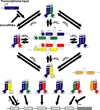Hand factors as regulators of cardiac morphogenesis and implications for congenital heart defects
- PMID: 21462297
- PMCID: PMC3119928
- DOI: 10.1002/bdra.20796
Hand factors as regulators of cardiac morphogenesis and implications for congenital heart defects
Abstract
Almost 15 years of careful study have established the related basic Helix-Loop-Helix (bHLH) transcription factors Hand1 and Hand2 as critical for heart development across evolution. Hand factors make broad contributions, revealed through animal models, to the development of multiple cellular lineages that ultimately contribute to the heart. They perform critical roles in ventricular cardiomyocyte growth, differentiation, morphogenesis, and conduction. They are also important for the proper development of the cardiac outflow tract, epicardium, and endocardium. Molecularly, they function both through DNA binding and through protein-protein interactions, which are regulated transcriptionally, posttranscriptionally by microRNAs, and posttranslationally through phosphoregulation. Although direct Hand factor transcriptional targets are progressively being identified, confirmed direct targets of Hand factor transcriptional activity in the heart are limited. Identification of these targets will be critical to model the mechanisms by which Hand factor bHLH interactions affect developmental pathways. Improved understanding of Hand factor-mediated transcriptional cascades will be necessary to determine how Hand factor dysregulation translates to human disease phenotypes. This review summarizes the insight that animal models have provided into the regulation and function of these factors during heart development, in addition to the recent findings that suggest roles for HAND1 and HAND2 in human congenital heart disease.
Copyright © 2011 Wiley-Liss, Inc.
References
-
- Ambros V. The functions of animal microRNAs. Nature. 2004;431(7006):350–355. - PubMed
Publication types
MeSH terms
Substances
Grants and funding
LinkOut - more resources
Full Text Sources
Medical



